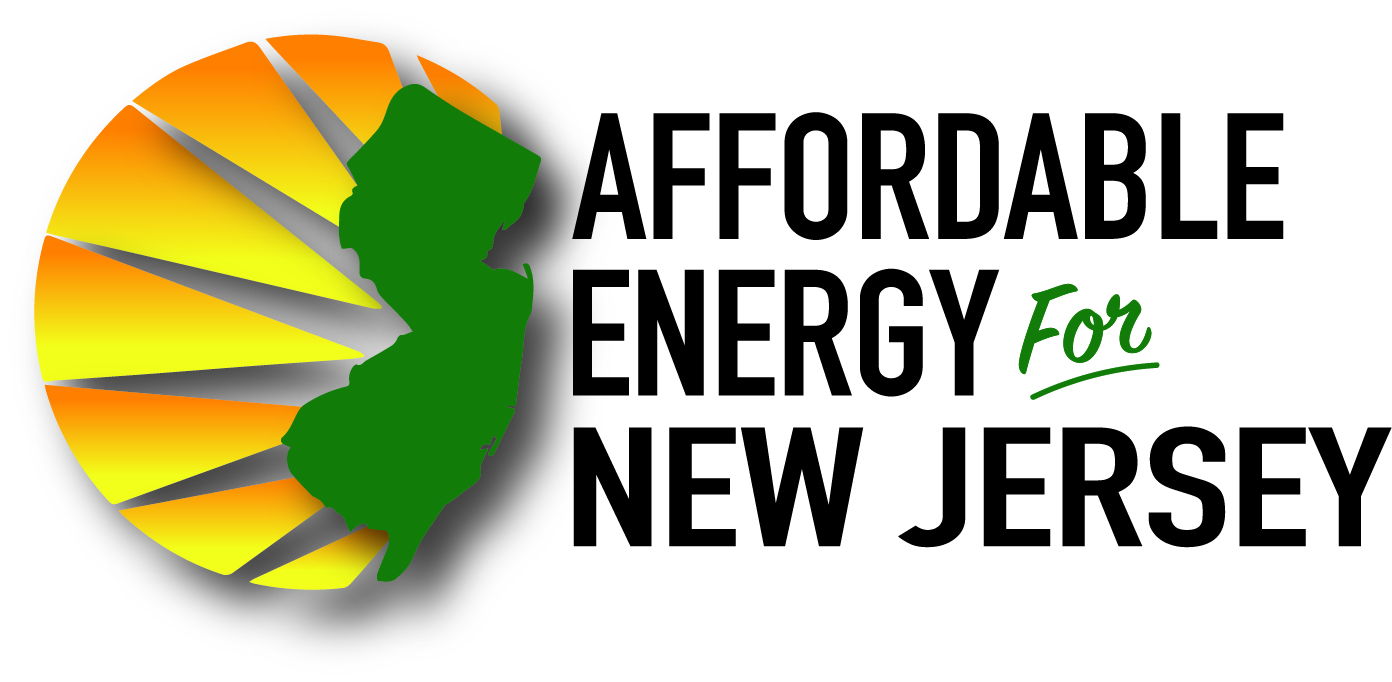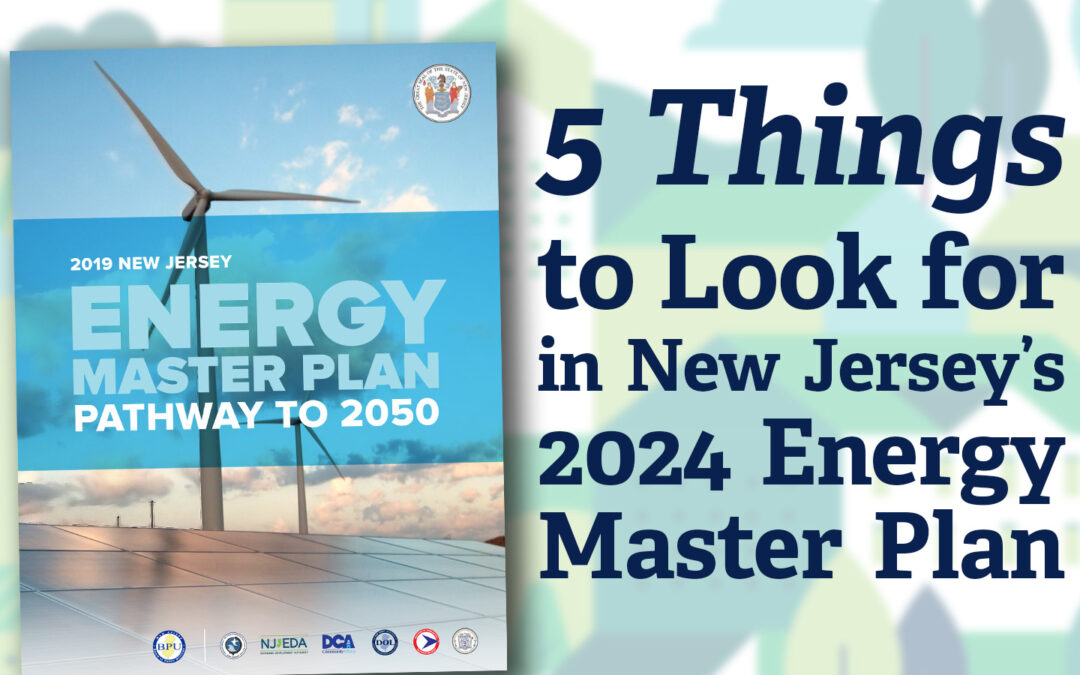The 2019 Energy Master Plan (2019 EMP) set very ambitious goals towards transitioning away from New Jersey’s core energy systems – nuclear and natural gas – and towards renewables, namely solar and offshore wind.
The New Jersey Board of Public Utilities (NJBPU) is working with consultants on the 2024 Energy Master Plan, which is expected to be released to the public by the end of the year. It will be the blueprint for energy policy decisions for the next five years.
Here are five things to look for in New Jersey’s 2024 Energy Master Plan:
1. Energy Resilience
“Since 1995 there have been 17 above-normal Atlantic hurricane seasons, as measured by NOAA’s Accumulated Cyclone Energy (ACE) Index. ACE calculates the intensity of a hurricane season by combining the number, wind speed and duration of each tropical cyclone. That’s the largest stretch of above-normal seasons on record.”
“How Climate Change May Be Impacting Storms Over Earth’s Tropical Oceans”, NASA
 New Jersey has experienced a significant increase in extreme weather events in recent years, driven largely by climate change. The state has seen more frequent and intense storms, including hurricanes, tropical storms, and heavy rainfall events. For instance, the number of storms resulting in extreme rain has increased by 71% over the last 50 years, a faster rate than anywhere else in the United States. These extreme weather events have led to widespread flooding, property damage, and disruptions to daily life.
New Jersey has experienced a significant increase in extreme weather events in recent years, driven largely by climate change. The state has seen more frequent and intense storms, including hurricanes, tropical storms, and heavy rainfall events. For instance, the number of storms resulting in extreme rain has increased by 71% over the last 50 years, a faster rate than anywhere else in the United States. These extreme weather events have led to widespread flooding, property damage, and disruptions to daily life.
During Superstorm Sandy in 2012, over 2.7 million New Jersey residents lost power, with some outages lasting for weeks. Sandy also knocked out power at the Passaic Valley Sewerage Commission water treatment plant for three days, leading to hundreds of millions of gallons of untreated sewage into local waterways.
More recently, intense thunderstorms in June 2024 left thousands without power due to wind gusts of up to 60 mph, along with hail and heavy rain. Additionally, a winter storm in January 2024 caused power outages for 46,000 residents.
It should be noted that wind and solar are intermittent energy sources and need to be supplemented by firm sources of energy like nuclear and natural gas or energy storage. The 2019 EMP plan aimed to achieve 600 MW of energy storage by 2021 and 2,000 MW by 2030. “The state’s storage goal is ‘the most aggressive one I’ve seen,’ Navigant Research senior research analyst Alex Eller told Utility Dive” in 2018. The state is far behind in meeting those goals. As of now, New Jersey has approximately 415 MW of energy storage across nine projects. This includes a significant 400 MW pumped-storage project – the Yards Creek Generating Station built in 1965.
These recent events highlight the need for a resilient energy grid to withstand and quickly recover from extreme weather, particularly for critical infrastructure like water treatment plants, hospitals and healthcare facilities, and for those with in-home medical needs that depend upon resilient power.
In the 2024 Energy Master Plan, look for how the NJBPU plans to make the energy grid more resilient.
2. Winds of Change
“Macroeconomic factors have changed dramatically over a short period of time, with high inflation, rising interest rates, and supply chain bottlenecks impacting our long-term capital investments…As a result, we have no choice but to cease development of Ocean Wind 1 and Ocean Wind 2.”
Ørsted Americas CEO David Hardy
“Wind drought has significant consequences. In September 2021, wind contribution to the UK electricity mix fell to just 2%, necessitating the reignition of two mothballed coal plants. In December 2022, the wholesale cost of UK spot electricity rose to a record high, driven by a fall in wind power and a rise in natural gas prices”
Shilpa Gahlot, “Climate Change and Wind Power: The Winds of Change”, Swiss Re Institute
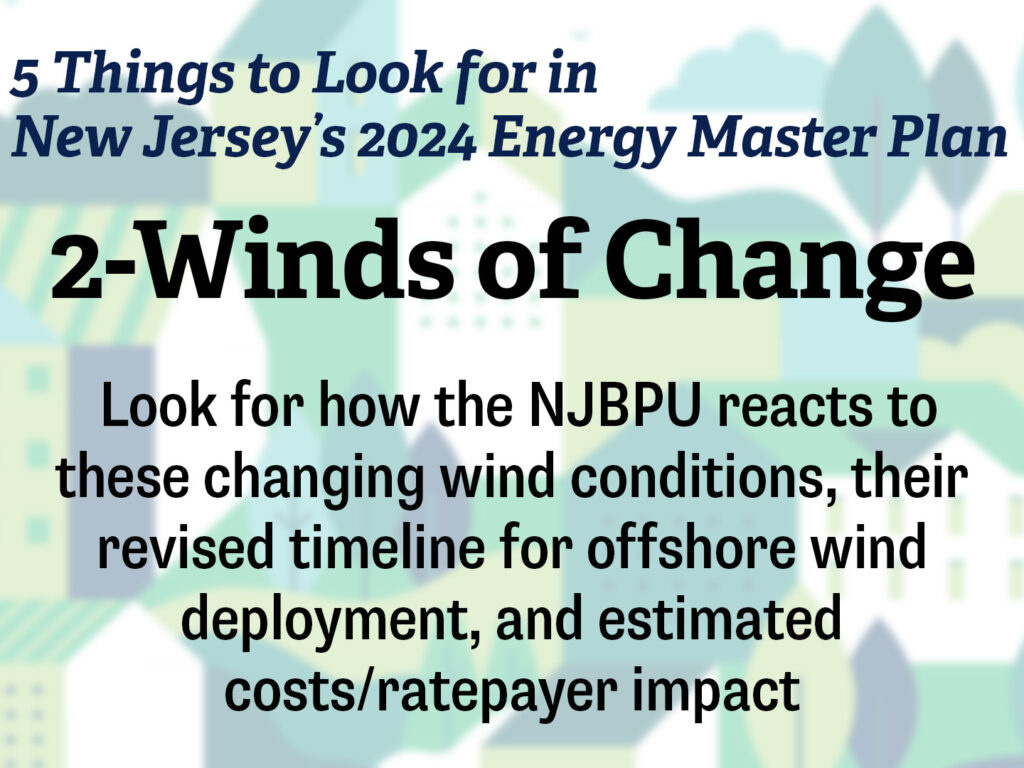 The 2019 EMP aims for 100% clean energy by 2050, including 7,500 megawatts (MW) from offshore wind. However, offshore wind projects have faced significant setbacks. Ørsted, a major wind developer, scrapped its Ocean Wind I and II projects due to supply chain issues, high interest rates, and insufficient tax credits. Other developers have encountered similar challenges, including rising costs and legal battles. These obstacles have raised concerns about the feasibility of meeting the state’s ambitious clean energy goals.
The 2019 EMP aims for 100% clean energy by 2050, including 7,500 megawatts (MW) from offshore wind. However, offshore wind projects have faced significant setbacks. Ørsted, a major wind developer, scrapped its Ocean Wind I and II projects due to supply chain issues, high interest rates, and insufficient tax credits. Other developers have encountered similar challenges, including rising costs and legal battles. These obstacles have raised concerns about the feasibility of meeting the state’s ambitious clean energy goals.
Adding to these challenges, Europe’s recent wind drought highlighted the vulnerability of relying heavily on wind energy. The prolonged period of low wind speeds led to reduced wind power generation, causing a spike in electricity prices. For instance, the UK saw a record high in wholesale electricity prices in December 2021. This increase in wholesale prices was passed on to consumers, resulting in higher energy bills. The wind drought underscored the need for a diversified energy mix to ensure stability and affordability.
Ørsted’s Ocean Wind 1 wind farm was expected to start generating power this year (2024). But with its cancellation, New Jersey is currently not producing any electricity from offshore wind, and current projects face the prospect of being embroiled in legal battles from local communities and additional economic pressures.
In the 2024 Energy Master Plan, look for how the NJBPU reacts to these changing wind conditions, their revised timeline for offshore wind deployment, and estimated costs/ratepayer impact
3. EV – Strategy vs. Market Reality
“Ford’s electric vehicle unit reported that losses soared in the first quarter to $1.3 billion, or $132,000 for each of the 10,000 vehicles it sold in the first three months of the year.”
John Lawler, CFO, Ford
Price remains the biggest obstacle as the average EV buyer has an annual income of about $150,000, which is twice the U.S. average.
“Ford Loses on its Electric Vehicle Sales; Lays Off Workers”, Institute for Energy Research
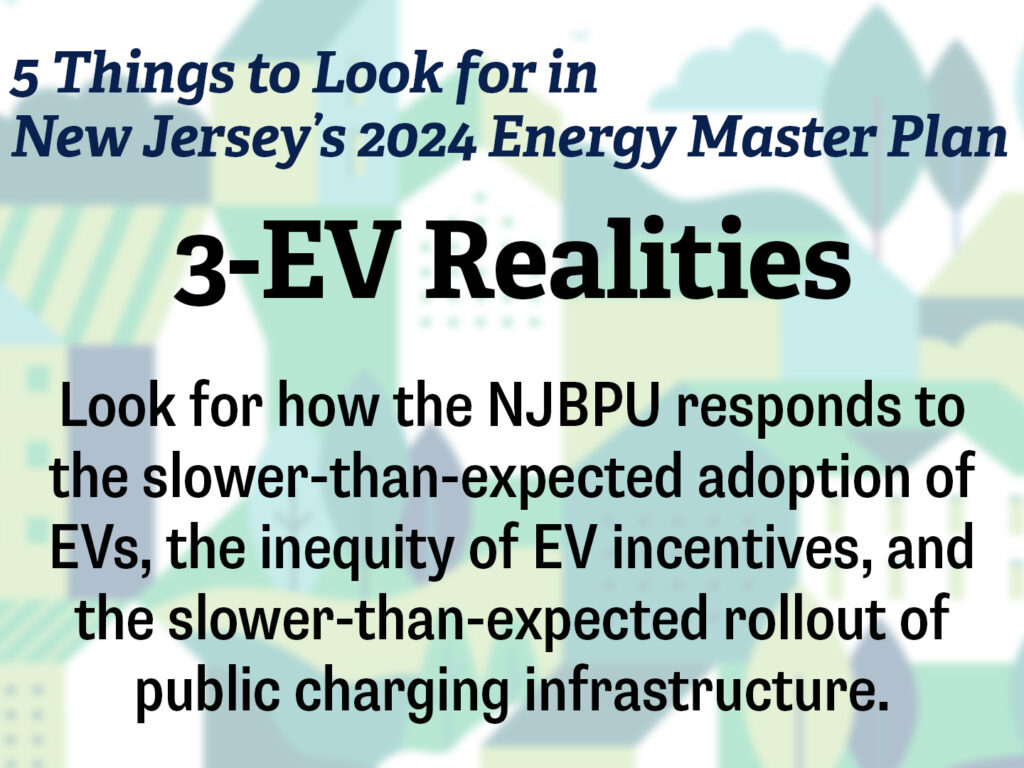 New Jersey’s 2019 EMP includes a significant focus on electrifying the transportation sector. The EMP aims to deploy 330,000 light-duty electric vehicles (EVs) by 2025. And in 2023, Governor Murphy signed Advanced Clean Cars II (ACC II) that commits the state to banning the sale of new gasoline-powered vehicles by 2035. The phasing out of gas-powered vehicles in New Jersey will start with 20% of new car sales being electric by 2026, increasing to 60% by 2030, and reaching 100% by 2035. But as of March 2024, New Jersey has only ~49,000 registered EVs.
New Jersey’s 2019 EMP includes a significant focus on electrifying the transportation sector. The EMP aims to deploy 330,000 light-duty electric vehicles (EVs) by 2025. And in 2023, Governor Murphy signed Advanced Clean Cars II (ACC II) that commits the state to banning the sale of new gasoline-powered vehicles by 2035. The phasing out of gas-powered vehicles in New Jersey will start with 20% of new car sales being electric by 2026, increasing to 60% by 2030, and reaching 100% by 2035. But as of March 2024, New Jersey has only ~49,000 registered EVs.
EV tax incentives have been a popular way to spur sales, but there are questions about equity. In California, a study found that half of the state’s EV rebates went to affluent areas, with only 7% going to disadvantaged communities. And while the operating costs of EVs may be lower than gas-powered vehicles (particularly for those with home charging), they are more expensive to purchase, and more difficult to charge for people living in apartments and those who park on the street.
New Jersey’s efforts to expand electric vehicle (EV) charging infrastructure through programs like “It Pays to Plug In” have shown little progress. As of 2022, New Jersey had approximately 2,008 EV chargers, which translates to 22.6 chargers per 100,000 residents. This is below the national average of 39 chargers per 100,000 residents. As of 2024, New Jersey has only 96 DC fast charging and 387 level 2 charging locations.
The market has simply not been as receptive to EVs as some had hoped. Major automakers like Ford and Volvo are retreating from their 100% EV goals due to the high costs and slow infrastructure rollout, instead shifting to more affordable hybrid vehicles that reduce greenhouse gas emissions while not being an additional financial or logistical burden on owners. There’s no way around it, EVs are more expensive, and tax incentives have proven to be inequitable. For example, a study found that half of California’s EV rebates went to affluent areas, with only 7% going to disadvantaged communities.
In the 2024 Energy Master Plan, look for how the NJBPU responds to the slower-than-expected adoption of EVs, the inequity of EV incentives, and the slower-than-expected rollout of public charging infrastructure.
4. Increased Energy Demands
“…one assessment suggests that ChatGPT, the chatbot created by OpenAI in San Francisco, California, is already consuming the energy of 33,000 homes. It’s estimated that a search driven by generative AI uses four to five times the energy of a conventional web search. Within years, large AI systems are likely to need as much energy as entire nations.”
Kate Crawford, “Generative AI’s environmental costs are soaring — and mostly secret”, Nature
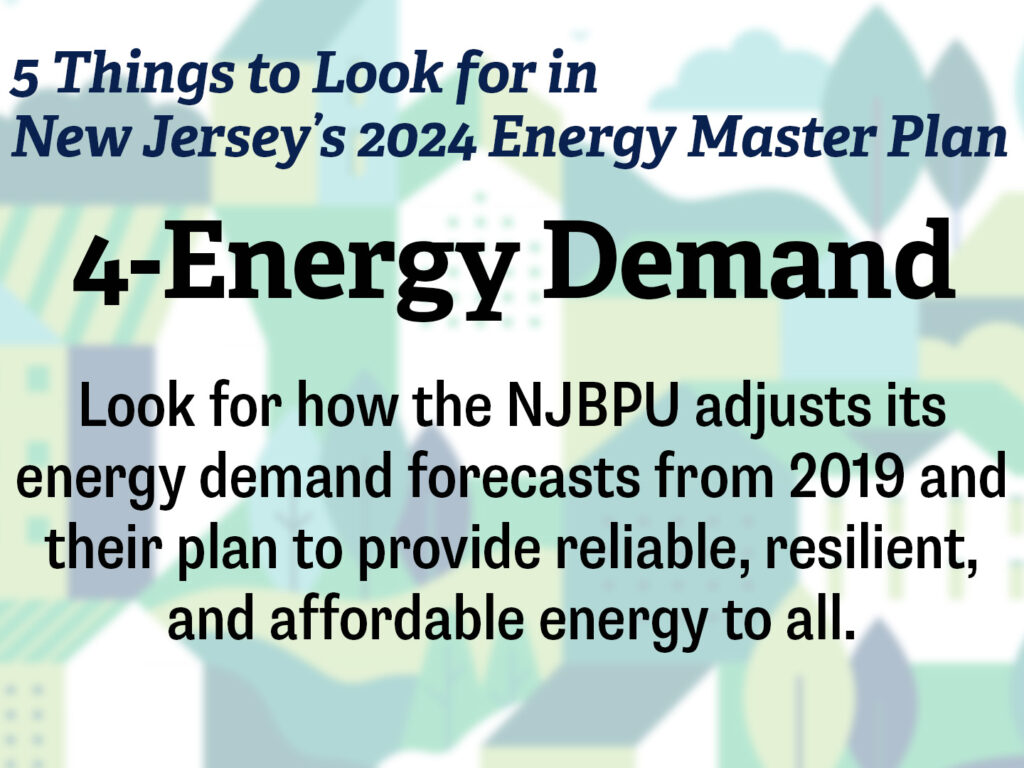 The 2019 EMP projected that increased energy efficiency would help reduce the growth curve of energy demand. By implementing measures such as utility energy efficiency standards, improving energy efficiency programs, and strengthening building and energy codes, the state aimed to curb the rise in energy consumption. These efforts were expected to offset some of the increased demand from electrification and economic growth.
The 2019 EMP projected that increased energy efficiency would help reduce the growth curve of energy demand. By implementing measures such as utility energy efficiency standards, improving energy efficiency programs, and strengthening building and energy codes, the state aimed to curb the rise in energy consumption. These efforts were expected to offset some of the increased demand from electrification and economic growth.
Current projections indicate a rapid increase in energy demand, driven by several factors, including the rise of artificial intelligence (AI). In July, Governor Murphy signed the Next New Jersey Program, aimed at attracting new investment into the state’s AI industry, spurring growth and economic opportunities. AI technologies, including data centers and machine learning models, require substantial amounts of electricity. For instance, AI servers could potentially use between 85 and 135 terawatt-hours (TWh) annually by 2027, equivalent to the Netherlands’ annual energy consumption.
Additionally, extreme weather events are becoming more frequent and severe due to climate change. This summer, New Jersey residents experienced a significant increase in electricity usage and utility bills. The state saw one of its hottest summers on record, with June 2024 being the second-warmest June since 1895. This extreme heat led to a surge in air conditioning use, which is typically the largest power draw in homes. Combined with recent NJBPU-approved rate hikes, many residents saw their electricity bills double or even triple compared to the previous year. Some households reported bills increasing from $149 to $495. Similarly, cold snaps can increase the need for heating, further straining the grid. Ensuring a reliable energy supply during these events requires robust infrastructure and a diversified energy mix.
In the 2024 Energy Master Plan, look for how the NJBPU adjusts its energy demand forecasts from 2019 and their plan to provide reliable, resilient, and affordable energy to all.
5. Ratepayer Impact
“The highlight of the administration’s efforts was hiring a consultant who ignored the capital costs of new equipment that ratepayers would have to purchase, such as electric stoves, heat pumps and electric vehicles, when assessing the costs of the 2019 Energy Master Plan. In the understatement of the year, a representative of the NJ BPU noted: ‘There needs to be additional analysis of the capital costs.’”
Frank Felder, former director of the Rutgers Energy Institute
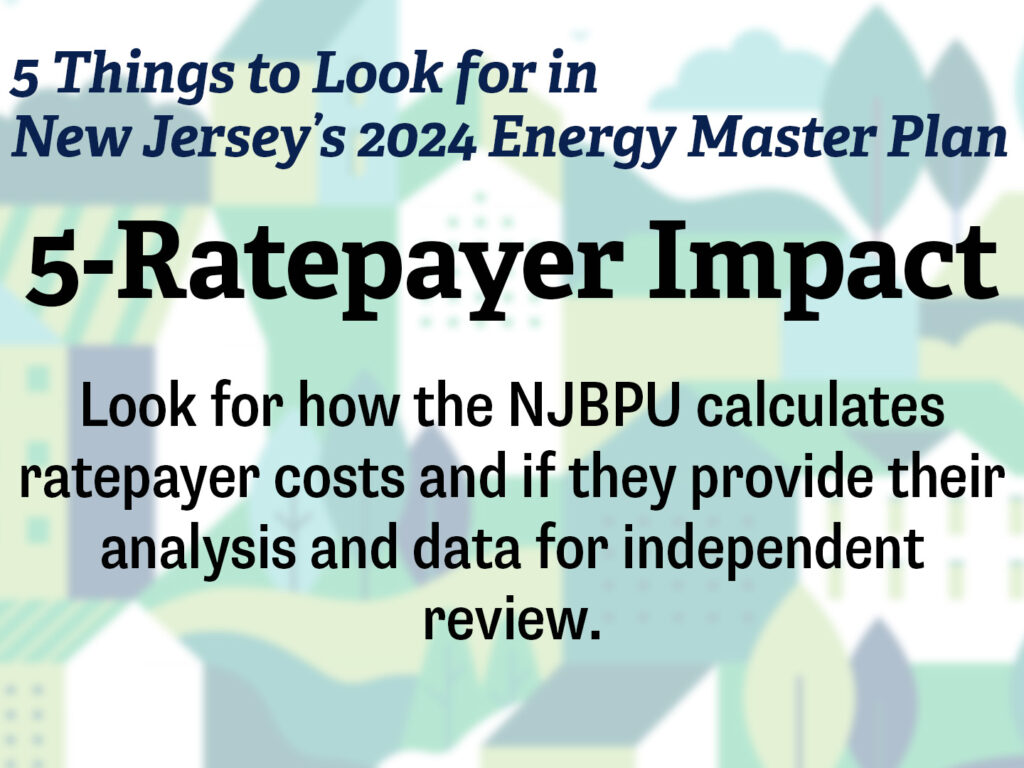 One of the major criticisms of the 2019 Energy Master Plan was insufficient analysis on ratepayer impacts. The New Jersey Division of Rate Counsel criticized the EMP for not focusing enough on the costs to ratepayers, especially low-income ratepayers who might struggle with any increases. Sarah Steindel, assistant deputy rate counsel, emphasized that the analysis should prioritize costs.
One of the major criticisms of the 2019 Energy Master Plan was insufficient analysis on ratepayer impacts. The New Jersey Division of Rate Counsel criticized the EMP for not focusing enough on the costs to ratepayers, especially low-income ratepayers who might struggle with any increases. Sarah Steindel, assistant deputy rate counsel, emphasized that the analysis should prioritize costs.
Energy poverty affects low-income households who struggle to afford basic energy services. These households often spend a significant portion of their income on energy bills, leading to difficult choices between heating, cooling, and other essential needs.
Approximately 1,268,636 households in New Jersey are classified as ALICE (Asset Limited, Income Constrained, Employed), representing about 36% of the state’s population.
The Rate Counsel highlighted that inflation could drive up the price of offshore wind projects by billions of dollars. They took issue with a provision in the state’s draft of a third effort to bolster offshore wind power, which includes the option to increase prices for Offshore Wind Renewable Energy Certificates (ORECs) by up to 15% in response to inflation. The guaranteed above-market power prices awarded to developers of these projects are expected to result in increased costs for all classes of ratepayers.
Frank Felder, former director of the Rutgers Energy Institute and former researcher at the Bloustein School of Planning and Public Policy, Rutgers University, published an op-ed in NJ Spotlight News saying that the 2019 EMP was overly ambitious, based on faulty modeling, and ignoring ratepayer costs.
An independent review by Jonathan A. Lesser, Ph.D., commissioned by Affordable Energy for New Jersey, pointed out numerous flaws in the Brattle Group’s EMP Ratepayer Impact Study. The review criticized the report for ignoring direct customer costs needed to achieve the EMP goals, such as installation costs for heat pumps and electric service upgrades.
In the 2024 Energy Master Plan, look for how the NJBPU calculates ratepayer costs and if they provide their analysis and data for independent review.
Conclusion
New Jersey’s Energy Master Plan is an important planning document that sets the course for energy rules and laws that impact all New Jerseyans. As such, great care should be taken to ensure that while the state addresses issues related to climate change, it also ensures that energy remains reliable, resilient, and affordable for all.
The 2024 Energy Master Plan is due by the end of the year.
Sources
-
- “How Climate Change May Be Impacting Storms Over Earth’s Tropical Oceans”, NASA https://science.nasa.gov/earth/climate-change/how-climate-change-may-be-impacting-storms-over-earths-tropical-oceans/
-
- Climate change in NJ: More storms, more rain, more often – Bergen Record. https://www.northjersey.com/story/news/environment/2021/08/30/climate-change-nj-storms-rainfall-infrastructure-flooding/5598806001/
-
- 2020 NEW JERSEY SCIENTIFIC REPORT ON CLIMATE CHANGE – The Official Web …. https://www.nj.gov/dep/climatechange/pdf/scientific-report-on-climate-change-at-a-glance.pdf
-
- State of the Climate: New Jersey 2023. https://njclimateresourcecenter.rutgers.edu/resources/state-of-the-climate-new-jersey/
-
- Climate Change in New Jersey: Temperature, Precipitation, Extreme …. https://dep.nj.gov/wp-content/uploads/dsr/trends-climate-change.pdf
-
- Climate Change in New Jersey: Impacts and Responses. https://njclimateresourcecenter.rutgers.edu/climate_change_101/climate-change-in-new-jersey-impacts-and-responses/.
-
- N.J. sets ‘aggressive’ 2 GW storage target by 2030 – Utility Dive. https://www.utilitydive.com/news/new-jersey-sets-aggressive-target-2-gw-by-2030-for-energy-storage/524422/
-
- New Jersey Electricity Dashboard – ArcGIS StoryMaps. https://storymaps.arcgis.com/stories/159302a1cdf7428290f44e9911226edd
-
- After Bold Promise, New Jersey’s Energy Storage Plan Remains a Mystery. https://www.greentechmedia.com/articles/read/new-jersey-bold-energy-storage-target-progress
-
- Energy Storage Mandates Continue to Develop. https://keycaptureenergy.com/energy-storage-mandates-continue-to-develop/
-
- Replacing Peaker Plants with Energy Storage in New Jersey. https://www.psehealthyenergy.org/work/opportunities-for-replacing-peaker-plants-with-energy-storage-in-new-jersey/
-
- New Jersey storm damage, power outages impact thousands following …. https://newjersey.news12.com/new-jersey-storm-damage-power-outages-impact-thousands-following-wednesday-thunderstorms
-
- January 9, 2024 – Winter storm slams central and eastern US. https://www.cnn.com/us/live-news/eastern-us-snow-storm-01-09-24/index.html
-
- NERC: Blackouts possible due to heat, weather this summer – New Jersey. https://newjersey.news12.com/nerc-blackouts-possible-due-to-heat-weather-this-summer
-
- Severe storms cause flash flooding, landslides throughout … – New Jersey. https://newjersey.news12.com/severe-storms-cause-flash-flooding-landslides-throughout-new-jersey
-
- European Natural Gas Prices Drop as Wind Power Soars. https://oilprice.com/Energy/Energy-General/European-Natural-Gas-Prices-Drop-as-Wind-Power-Soars.html
-
- What Europe’s exceptionally low winds mean for the future energy grid. https://theconversation.com/what-europes-exceptionally-low-winds-mean-for-the-future-energy-grid-170135
-
- “Climate Change and Wind Power: The Winds of Change”, Swiss Re Institute https://www.swissre.com/institute/research/topics-and-risk-dialogues/climate-and-natural-catastrophe-risk/climate-change-wind-power.html
-
- Lower demand, falling gas prices drive European electricity prices down. https://www.pv-magazine.com/2024/09/17/lower-demand-falling-gas-prices-drive-european-electricity-prices-down
-
- Prices for gas in Europe are lower due to steady Russian and Norwegian supplies. https://www.worldenergynews.com/news/prices-for-gas-europe-are-lower-due-752446
-
- Chasing the Sun and Catching the Wind: Energy Transition and … – IMF. https://www.imf.org/en/Publications/WP/Issues/2022/11/04/Chasing-the-Sun-and-Catching-the-Wind-Energy-Transition-and-Electricity-Prices-in-Europe-525079
-
- Lack of chargers slowing NJ move to EVs | NJ Spotlight News. https://www.njspotlightnews.org/2022/11/electric-vehicles-evs-charging-stations-range-anxiety-co-pilot-fast-chargers/
-
- New Jersey Electric Vehicle & EV Charging Statistics. https://qmerit.com/blog/statistics-on-ev-charging-stations-in-new-jersey
-
- NJDEP| Drive Green NJ | It Pays to Plug In – New Jersey Department of …. https://dep.nj.gov/drivegreen/it-pays-to-plug-in
-
- NJDEP| Grant and Loan Programs | EV CHARGING STATIONS. https://dep.nj.gov/grantandloanprograms/fact-sheets/fact-sheet-ev-charging-stations
-
- Official Site of The State of New Jersey – The Official Web Site for …. https://www.nj.gov/governor/news/news/562022/20220725a.shtml
-
- Overview of Statewide EV Ordinance – New Jersey Department of …. https://dep.nj.gov/wp-content/uploads/drivegreen/pdf/mud-toolkit/evse-requirements-for-new-mud-construction.pdf
-
- Electrify America Charging Station. https://www.electrifyamerica.com/
-
- Electric Charging Station. https://afdc.energy.gov/fuels/electricity-locations
-
- NJDEP| Drive Green NJ | NJ EV Data – New Jersey Department of …. https://dep.nj.gov/drivegreen/nj-ev-data
-
- NJDEP| Drive Green NJ | Charging – New Jersey Department of …. https://dep.nj.gov/drivegreen/charging/
-
- A Complete Guide on New Jersey EV & Charging Station Incentives. https://www.ny-engineers.com/blog/ev-and-charging-station-incentives-in-new-jersey-the-complete-guide
-
- Volvo backtracks on its 100% EV pledge: Here’s what to expect – Electrek. https://electrek.co/2024/09/04/volvo-backtracks-100-ev-pledge/
-
- Combustion Going Bust: Global Phase-outs of Gasoline Cars. https://www.statista.com/chart/29359/official-targets-phase-out-sale-gasoline-cars/
-
- The Hidden Costs of the EV Retreat – TIME. https://time.com/7019622/hidden-costs-ev-retreat-supply-chain/
-
- NJDEP| Drive Green NJ | NJ EV Data – New Jersey Department of …. https://dep.nj.gov/drivegreen/nj-ev-data/
-
- Electric Cars vs. Gas Cars: What to Know Before Buying. https://www.nerdwallet.com/article/cars/car-shopping/electric-cars-vs-gas-cars
-
- EV Rebates in Calfornia Help the Affluent the Most: Study – Jalopnik. https://jalopnik.com/ev-rebates-in-calfornia-help-the-affluent-the-most-stu-1850403777
-
- Canada lays out plan to phase out sales of gas-powered cars, trucks by …. https://www.cbc.ca/news/politics/canada-electric-vehicles-2035-1.7063993
-
- Volvo Admits Defeat, Won’t Go Fully Electric by 2030 – Motor1.com. https://www.motor1.com/news/732504/volvo-backtracks-ev-goal-2030/
-
- Ford just reported a massive loss on every electric vehicle it sold. https://finance.yahoo.com/news/ford-just-reported-massive-loss-214534613.html
-
- Here’s the Staggering Amount of Money Ford Loses on Each EV It Makes. https://finance.yahoo.com/news/heres-staggering-amount-money-ford-140300424.html
-
- Ford Loses This Whopping Amount of Money on Each EV It Makes. https://www.fool.com/investing/2023/05/13/ford-loses-this-whopping-amount-of-money-on-each-e/
-
- Ford loses $47k per EV sold as electric bet backfires – MSN. https://www.msn.com/en-us/money/companies/ford-loses-47k-per-ev-sold-as-electric-bet-backfires/ss-BB1hZ3c4
-
- Ford Loses on its Electric Vehicle Sales; Lays Off Workers. https://www.instituteforenergyresearch.org/renewable/ford-loses-on-its-electric-vehicle-sales-lays-off-workers/
-
- Ford cuts EV plans even as it becomes nation’s second-largest EV brand. https://arstechnica.com/cars/2024/04/fords-q1-ev-sales-grew-86-but-its-shifting-focus-to-hybrids
-
- Ford dramatically scales back EV plant amid plummeting sales in … – MSN. https://www.msn.com/en-us/money/other/ford-dramatically-scales-back-ev-plant-amid-plummeting-sales-in-blow-to-biden-s-green-energy-goals/ar-AA1kiMO1
-
- Gasoline Vehicle Phaseout Advances Around The World. https://coltura.org/world-gasoline-phaseouts/
-
- Biden’s Plan To Phase Out Gas-Powered Cars Is All Pain for Consumers …. https://www.heritage.org/government-regulation/commentary/bidens-plan-phase-out-gas-powered-cars-all-pain-consumers-and-no
-
- California offers additional $14,000 in low-income EV incentives. https://www.electrive.com/2024/06/24/california-ev-incentives-14000-low-income-residents/
-
- Use CALZI Data Dashboard to Analyze $1.46 Billion in California ZEV …. https://energycenter.org/thought-leadership/blog/use-calzi-data-dashboard-analyze-146-billion-california-zev-incentives
-
- California electric vehicle tax credits, rebates and incentives. https://www.edmunds.com/electric-car/tax-credits-rebates-incentives/california/
-
- California Energy Commission Launches $38 Million Project for EV …. https://www.energy.ca.gov/news/2023-09/california-energy-commission-launches-38-million-project-ev-charging-low-income
-
- Official Site of The State of New Jersey – The Official Web Site for …. https://www.nj.gov/governor/news/news/562022/20220725a.shtml
-
- Eight New Jersey Turnpike Service Areas to Add Electric Vehicle Chargers. https://www.i95exitguide.com/roadnews/eight-new-jersey-turnpike-service-areas-to-add-electric-vehicle-chargers/
-
- NJ charging stations for electric vehicles coming to tourist spots. https://www.app.com/story/news/local/land-environment/2022/03/22/nj-charging-stations-electric-vehicles-coming-tourist-spots/7113613001/
-
- NJDEP| Drive Green NJ | It Pays to Plug In – New Jersey Department of …. https://dep.nj.gov/drivegreen/it-pays-to-plug-in/
-
- Tesla agreement | NJTA – New Jersey Turnpike Authority. https://www.njta.com/newsroom/tesla-agreement
-
- Gas vs Electric Cars: Compare Fuel, Maintenance & Ownership Costs – EV Life. https://evlife.co/blog/evs-vs-gas-powered-costs
-
- Electric vs. Gas Cars: What Are the Hidden Environmental Costs of EVs …. https://www.pcmag.com/opinions/electric-vs-gas-cars-what-are-the-hidden-environmental-costs-of-evs
-
- Electric Cars vs. Gas Cars: What Do They Cost? – EnergySage. https://www.energysage.com/electric-vehicles/evs-vs-fossil-fuel-vehicles/
-
- EVs Offer Big Savings Over Traditional Gas-Powered Cars. https://www.consumerreports.org/hybrids-evs/evs-offer-big-savings-over-traditional-gas-powered-cars/
-
- Energy Master Plan | About the Energy Master Plan – The Official Web …. https://www.nj.gov/emp/energy/
-
- Energy Efficiency 2020 – Analysis – IEA. https://www.iea.org/reports/energy-efficiency-2020
-
- Energy Master Plan | EMP Documents – The Official Web Site for The …. https://www.nj.gov/emp/docs
-
- Energy efficiency in 2019 – Energy Efficiency 2020 – Analysis – IEA. https://www.iea.org/reports/energy-efficiency-2020/energy-efficiency-in-2019
-
- 2019 Sustainability Report and Implementation Plan – Department of Energy. https://www.energy.gov/sites/prod/files/2019/11/f68/DOE%202019%20Sustainability%20Report%20and%20Implementation%20Plan.pdf
-
- Guide to Energy Master Planning of High-Performance Districts and …. https://betterbuildingssolutioncenter.energy.gov/resources/guide-energy-master-planning-high-performance-districts-and-communities
-
- Generative AI’s environmental costs are soaring — and mostly secret”, Nature. https://www.nature.com/articles/d41586-024-00478-x
-
- IN THE MATTER OF THE 2024 NEW JERSEY ENERGY MASTER PLAN. https://www.nj.gov/bpu/pdf/publicnotice/5.13.24%20Energy%20Master%20Plan%20-%20Public%20Hearing%20Questions%20RFI%20-%20FINAL.pdf.
-
- NJ electricity bills soared for some customers in June. Here’s why. https://www.northjersey.com/story/news/2024/07/25/nj-electricity-bills-soared-june/74511604007/
-
- Average Electricity Bill in New Jersey (and How to Save). https://www.msn.com/en-us/money/personalfinance/average-electricity-bill-in-new-jersey-and-how-to-save/ar-AA1qKfCm
-
- New Jersey Dems Propose New System to Keep Track of Skyrocketing Energy Costs. https://www.shorenewsnetwork.com/2024/09/10/new-jersey-dems-propose-new-system-to-keep-track-of-skyrocketing-energy-costs/
-
- New Jersey Is the Latest Victim of High Electricity Prices. https://townhall.com/columnists/kristen-walker/2024/09/07/new-jersey-is-the-latest-victim-of-high-electricity-prices-n2644437
-
- NJ electric bill sky high this summer? The heat is one factor. https://nj1015.com/nj-electric-bill-sky-high-summer-2024/.
-
- Rate counsel urges slowdown of offshore wind development in NJ | NJ …. https://www.njspotlightnews.org/2022/12/offshore-wind-development-nj-raises-costs-rate-payers/
-
- NJ offshore wind could get pricier due to inflation, Rate Counsel says. https://www.app.com/story/news/local/land-environment/2023/01/13/nj-offshore-wind-could-get-pricier-due-to-inflation-rate-counsel-says/69802231007/
-
- Impact of New Jersey Offshore Wind Program on State Electric Rates. https://defendbrigantinebeach.org/wp-content/uploads/2024/04/Impact-of-Offshore-Wind-on-NJ-Electric-Rates-Whitestrand-Consulting-LLC-Nov-2023.pdf
-
- Brattle Study of NJ Energy Master Plan Cost Under Scrutiny. https://www.rtoinsider.com/29857-brattle-study-nj-energy-master-plan-cost/
-
- Op-Ed: The NJ Energy Master Plan mulligan – njspotlightnews.org. https://www.njspotlightnews.org/2023/02/federal-inflation-reduction-act-of-2022-regional-greenhouse-gas-initiative-energy-master-plan-2023-2024-whale-deaths-covid-19-offshore-wind-turbines-offshore-wind-farms-nj-rate-counsel-environmental/
-
- Reassessing NJ’s Energy Master Plan | NJ Spotlight News. https://www.njspotlightnews.org/2024/03/bpu-announces-review-nj-energy-master-plan/
-
- The Brattle Group Report: “New Jersey Energy Master Plan, Ratepayer …. https://njaffordableenergy.com/wp-content/uploads/2022/08/RatePayer-Impact-Study-independent-analysis-final-v2.pdf
-
- NJ BPU Approves Report on Costs of Energy Master Plan. https://www.rtoinsider.com/30657-nj-bpu-approves-report-costs-energy-master-plan/
-
- New Jersey Energy Master Plan – The Official Web Site for The State of …. https://nj.gov/bpu/pdf/reports/2022-08-13%20-%20BPU,%20EMP%20Ratepayer%20Impact%20Study%20Report_PUBLIC_Brattle.pdf.
-
- ALICE | United Way of NNJ. https://www.unitedwaynnj.org/alice
-
- ALICE IN NEW JERSEY: A FINANCIAL HARDSHIP STUDY – UnitedForALICE. https://www.unitedforalice.org/Attachments/AllReports/2020ALICEReport_NJ_FINAL.pdf
-
- Who is ALICE? | Social Impact and Community Investment – RWJBarnabas Health. https://www.rwjbh.org/why-rwjbarnabas-health-/social-impact/social-impact-and-community-investment-strategic/who-is-alice-/
-
- New Jersey | UnitedForALICE. https://www.unitedforalice.org/state-overview-mobile/new-jersey
-
- New Jersey | UnitedForALICE. https://www.unitedforalice.org/new-jersey
